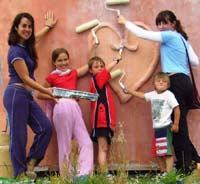Vicky and her four kids were living off-grid in Ireland. Now they are back on the grid.

It’s a family affair
Before moving into my new eco-home, I spent 7 years living off the grid in a very simple lifestyle, but found that it was unsustainable with FOUR small children involved. Now we live in an eco-house I designed and built with other members of our ecological Foundation.
Back when we were living off-grid we had a very small turbine that generated enough power for the lights when there had been a wind and for a bit of music, but with kids it wasn’t enough: there was a lot of washing of clothes that needed to be done for them to be accepted at the local school and fit in;as the eldest grew up she found that it was more difficult to relate with her peers as we didn’t have a t.v. (and with only having a compost toilet, she didn’t feel that she could invite friends from school around!)
We used paraffin lamps and candles to supplement the lighting, which I found very hard when it was winter and still dark in the morning when I was trying to get them ready for school and dripping candle wax over the clothes i was trying to check were clean!
Also, living in a small space with small children on a wet winter evening was difficult with candles around!
I feel like we were living in a quite extreme way, so i wouldn’t say it would be too difficult to adapt the power needs to a family situation, but it certainly becomes more complicated to live that kind of lifestyle and keep the kids integrated into the local community.
Now I live with my 4 kids in a house I designed and built myself with other members of our Unicorn Ecological Foundation. I feel that the way it is happening now, people can see that you can still live a comfortable life whilst going for alternative power options. Mind you � we keep ourselves busy.
The planting of 20,000 trees in the past three months has taken absolute priority. We are very excited about the Dawn Seqouia’s that we now have 100 of: trees that were thought to be extinct until they were rediscovered in China in 1941: they like wet ground and the wood is fire resistant. As we have a lot of bog around us, I think they may do really well.
We are a teaching centre designed to promote ways of living a lifestyle in balance with the planet and its’ dwindling resources.
My new house is a timber frame construction, partly subterranean, with lime-crete render and Douglas fir cladding on the outer walls, and recycled rubber tiles on the roof. It is heated by an underfloor geothermal array from the bog out back. This is pumped around the house at night time.
At present we are starting the process of going off the grid by creating a wind turbine/ hydro pump system, that we are hoping will be in place in the next year or so: this will provide the power needs of the whole centre.
The way that the matter is being approached now is a process that could be replicated by larger communities such as towns or villages, which would be very exciting, as well as encouraging more individuals to go for it themselves in a practically sustainable way.
3 Responses
Am just starting out on my eco journey, found the TV the easiest part to integrate, got low voltage, and bobs your uncle.
The jacks is another matter. I cant stand compost toilets, so, when Ive the cash together, Ill be installing a gas incinerating loo.
But thats all ahead of me yet!
Sequioa is not a native Irish species, it’s ecologically unsound to use non-native species. Also, your ‘sustainable’ energy plan involves creating two large lakes for a pumped storage system – has any EIA been done, I imagine this will have major impact on the mountain environment in particular.
You seem pretty gung ho for an ‘Ecological Foundation’
I have just read your article with great interest. What an inspiration! Its interesting to read what someone has to say from a possition of experience. So much is writen from an idealised theoretical perspective. Also, how often to we “inflict” our ethos on our kids without taking their needs into consideration. I believe that living off-grid should be able to support the basic needs. For a child this should include acceptability of peers and as we age we should ensure the comfort of warmth and ease of maintainance.
I hope Vicky’s kids appreciate what she has created for them.